Trip leader(s): Josep Anton Muñoz, Pablo Granado and Eduard Roca
Limit: 20 Participants
The aim of this 2-day field trip is the recognition of the key structural features of a fold and thrust belt detached on salt that has resulted from the inversion of a previous passive margin. To achieve this objective, some of the key and most spectacular localities of the southern Pyrenees have been selected along the ECORS-Pyrenees transect. This is a reference cross-section provided that for many years a huge amount of geological and geophysical data sets has been collected and integrating into a kinematic model of the South-Pyrenean fold and thrust belt. Subsurface data (well logs and seismic sections) will be combined with field observations. One of the main characteristics of the southern Pyrenees is the preservation of the synorogenic sediments since the earlier stages of deformation, which not only provide time constraints but also allow us discussion of kinematics of fault-related folds and thrust systems. Finally, the mild contractional deformation permits deciphering the initial geometry of the rift system and the salt structures that configure the structural grain of the passive margin before the inversion, allowing discussion of the role that these structures play during the fold and thrust belt development.
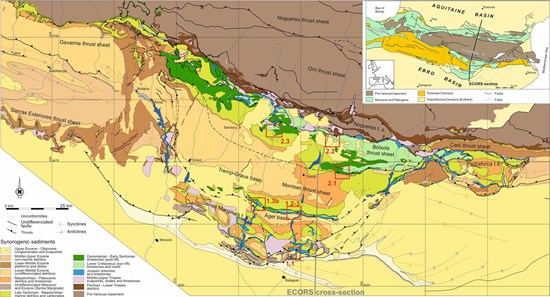
Itinerary: (day by day details of the trip)
Day 1
Stop 1.1: The South-Pyrenean thrust front. Sant Llorenç de Montgai
Structure of a frontal thrust system and related unconformities. Out of sequence thrusts and synorogenic sediments.
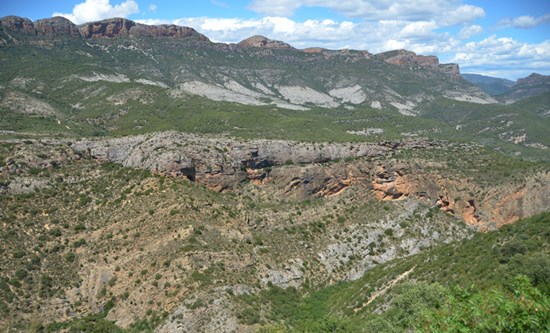
The frontal thrust system of the South-central Pyrenees has been detached into the Triassic evaporites and involves a thin Mesozoic succession. It is characterized by an emergent thrust system during the sedimentation of upper Eocene and lower Oligocene continental sediments. Frontal thrusts were progressively buried by conglomerates, triggering a break-back thrusting sequence and the development of out-of-sequence thrusts bringing together strongly different Mesozoic successions, such as the Montroig thrust in the picture.
Stop 1.2: The Ager basin and the Montsec thrust sheet. Fontllonga
The Ager basin in the footwall of the Montsec thrust.
The Montsec thrust sheet developed from the Paleocene to the Early Eocene as recorded by continental to shallow marine sediments deposited in its footwall (Ager basin) as well as in the Tremp-Graus piggy-back basin. The lower Eocene sediments of these basins grade westward into the slope succession filling the Ainsa basin at the footwall of the Montsec thrust.
Stop 1.3: The frontal structure of the Montsec thrust sheet. Ametlla (optional: Montrebei)
Fault-propagation fold related with the inversion of Early Cretaceous extensional faults and growth deltaic sediments in the footwall syncline.
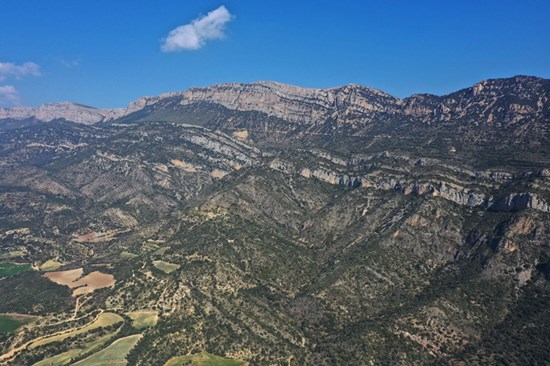
The Montsec thrust sheet involves the northern part of the Upper Cretaceous foreland basin characterised by a strong subsident turbiditic trough at the footwall of the Bóixols thrust. These turbidites grade southward into a carbonatic platform that constitutes the backbone of the Montsec Range (main ridge and cliff of the pictures). Underneath the Upper Cretaceous carbonates, some Early Cretaceous extensional faults are preserved in the hanging wall of the Montsec thrust, but others have controlled the development of a hanging wall frontal anticline. The geometry of this anticline as well as the structure of the growth sediments in the footwall Ager syncline are visible in the field. The subthrust geometry will be discussed integrating surface observations and the available seismic and well data.
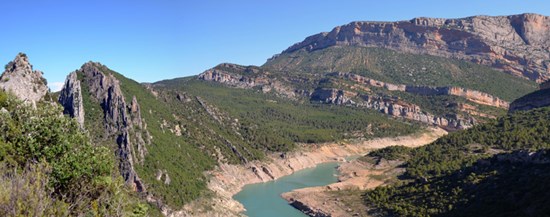
Overnight in Tremp
Day 2
Stop 2.1: The Sant Corneli-Bóixols anticline
Inversion of the rift margin
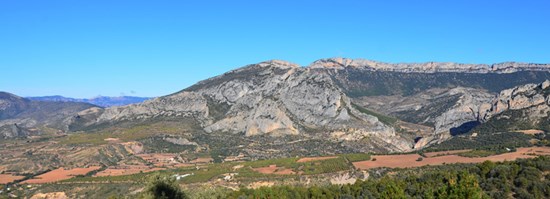
The Sant Corneli-Bóixols anticline is the most prominent frontal structure of the Bóixols thrust sheet in the central Pyrenees. This fold trends east–west and crops out for greater than 40 km along strike. The Sant Corneli-Bóixols anticline involves a thick Mesozoic succession detached on top of Triassic evaporites. The prefolding sequence consists of up to 5 km of prerift, synrift, and postrift carbonates ranging in age from Jurassic to Upper Cretaceous. Synfolding Upper Cretaceous sediments start with the upper Santonian carbonates and continue with a succession of Campanian and Maastrichtian marls and turbidites.
The Sant Corneli–Bóixols anticline is an example of an inversion fold developed along the rift margin of the Lower Cretaceous basin. Its geometry is related with the inverted extensional system. In particular, the three-dimensional geometry, including the saddles between culminations, is inherited from the previous transfer faults of the segmented rift margin.
Available seismic data and 3 exploratory wells constrain the geometry at depth.
Stop 2.2: The synororgenic Paleogene conglomerates
Inverted Lower Cretaceous basin and Eocene-Oligocene synorogenic conglomerates at Collegats gorge.
Stop 2.3 (optional): The Sopeira and Aulet minibasins. Sopeira
Minibasins developed by extensional collapse and salt evacuation during the thermal subsidence at the southern Pyrenean rift margin. Inversion of these mini-basins at the early stages of Pyrenean contractional deformation during Late Cretaceous.
Additional logistic information
Transportation
Transportation will be with a small bus, assisted by minivans to have access to some of the outcrops.
Physical demand, equipment and safety
This is an easy field trip with very easy and limited hikes to get to the outcrops. Outcrops will be from main sealed roads.
Safety vests will be available, to be used by everybody of the group wherever required and asked to. There will be First Aid Kits available in each car during fieldwork.